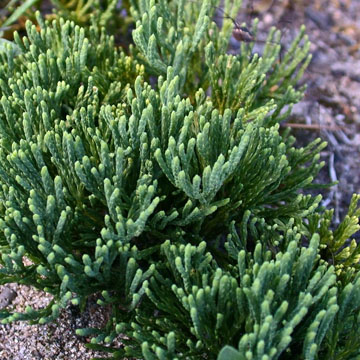

Diphasiastrum tristachyum - (image 1 of 5)
Taxonomy
Family: Lycopodiaceae
Habitat
Sterile, thin or sandy acidic soils.
Associates
Distribution
Newfoundland and Labrador to Manitoba, south to MD, VA, IN, and MN, south in mountains to SC, GA, and AL.
Morphology
Low evergreen from horizontal stems on the surface or just below soil level. Upright shoots clustered, branching near the base; branchlets squarish-terete, 1-2.2 mm in diameter, subdichotomous, somewhat glaucous beneath, annual bud constrictions abrupt and conspicuous. Leaves on branchlets 4-ranked, appressed. Strobili (2-)3-4(-7), up to 2.8 cm long, terminal, blunt at the apex, sterile tips lacking; stalks forked at uniform distances.
Notes
Spores produced August to September
Wetland indicator: FAC
The bluish color of plants growing in the open makes this species relatively easy to identify. Plants growing in some shade tend to be greener and can then be identified with a little more difficulty by the narrow, rounded branches. The branches of D. digitatum and D. complanatum are noticeably flatter and the former lacks annual bud constrictions.
References
Gleason, Henry A.
and A. Cronquist. 1991. Manual of Vascular Plants of Northeastern United States
and Adjacent Canada. Second Ed.
The New York Botanical Garden. Bronx, NY.
USDA, NRCS. 2002. The PLANTS Database, Version 3.5 (http://plants.usda.gov).
National Plant Data Center, Baton Rouge, LA 70874-4490 USA.
Wagner, W.H. Jr. and Beitel, J.M. 1993. Lycopodiaceae. In: Flora of North America North of Mexico, Vol. 2.
Oxford University Press, New York and Oxford.
|
Michael Hough © 2018 |